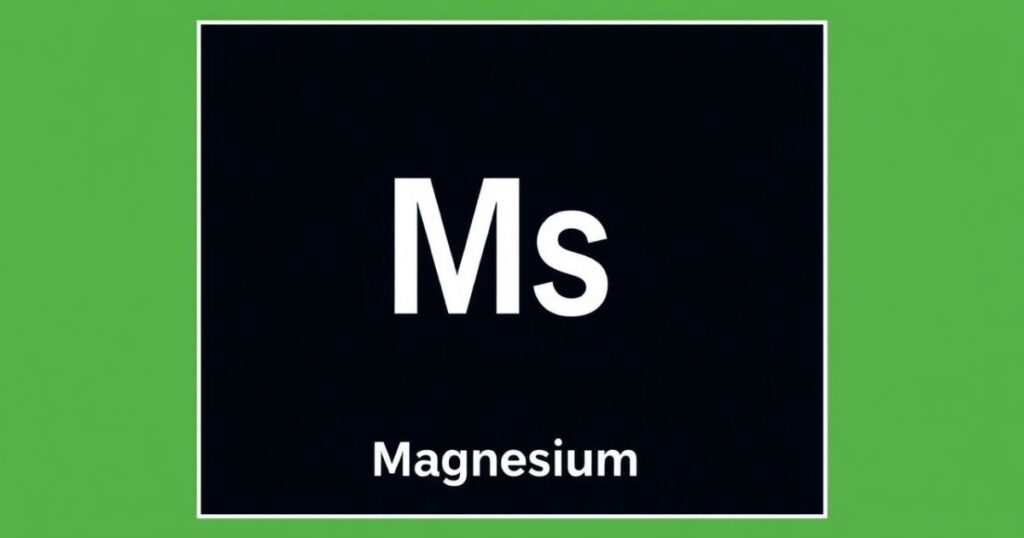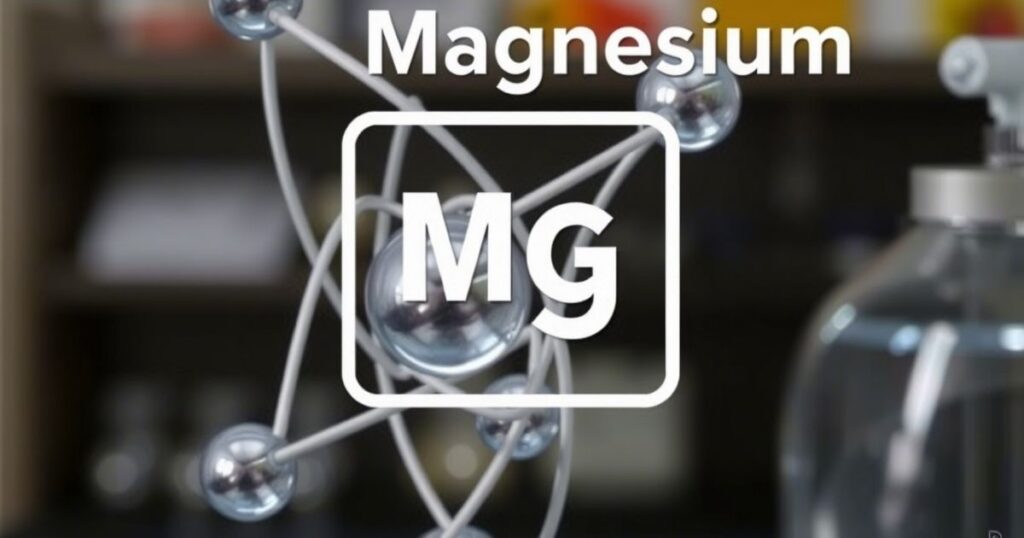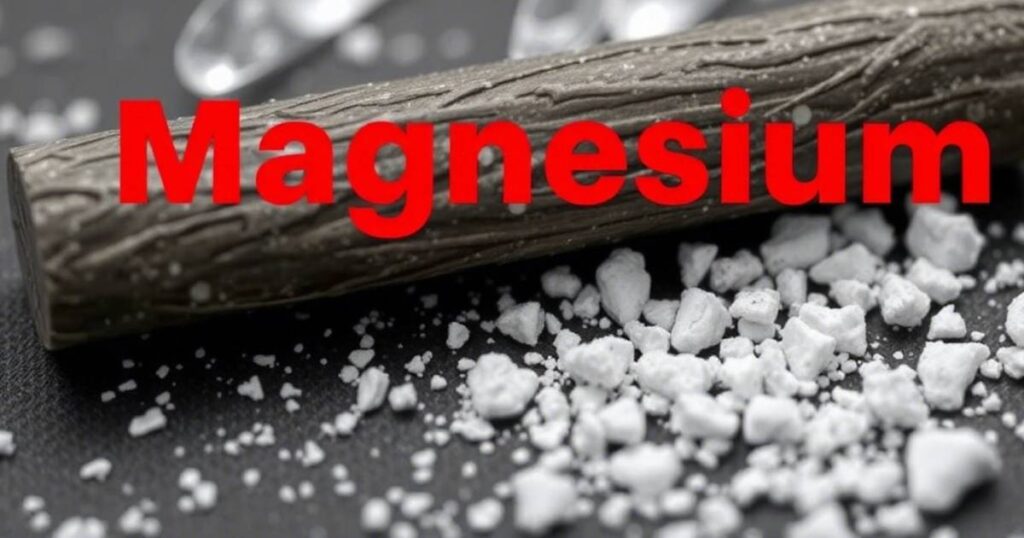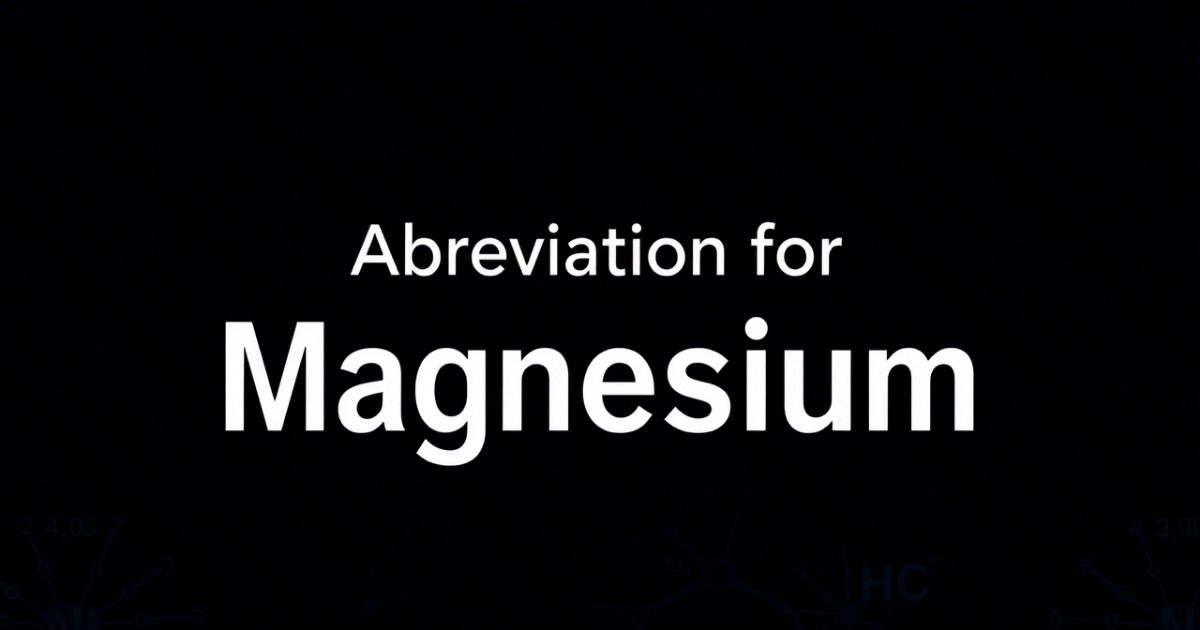The abbreviation for magnesium is “Mg.” This abbreviation is used frequently in science, especially in chemistry. Magnesium is an essential element on the periodic table. The abbreviation for magnesium makes it easy to write formulas and discuss reactions. It is a metal found in many minerals.
Magnesium plays a big role in our health. It helps with muscle function, nerve function, and energy production. You can find magnesium in foods like nuts and leafy greens. It is also important for bone health. The abbreviation for magnesium is often seen in health discussions and scientific articles. Understanding magnesium is important for both science and everyday health.
What is the Abbreviation for Magnesium?
The symbol for magnesium is Mg, derived from “magnesia,” a region in Greece where magnesium-rich minerals were first discovered. This abbreviation is commonly recognized in scientific fields.
Magnesium is vital for the human body, playing a key role in muscle function, nerve signaling, and bone health. It is measured in medical tests to track magnesium levels. In chemistry, Mg appears on the periodic table as an alkaline earth metal, essential for various reactions. Magnesium compounds, like magnesium oxide (MgO), have many industrial applications.
Magnesium is also crucial for agriculture. It enhances soil quality and supports plant growth, as it is a core component of chlorophyll. Additionally, magnesium alloys are used in the aerospace and automotive industries to create lightweight materials.
What Does Abbreviation for Magnesium Mean?
The abbreviation for magnesium is Mg. It is the symbol used to represent magnesium on the periodic table of elements. This shorthand is common in scientific discussions.
Magnesium is an essential mineral for the human body. It plays a key role in muscle function, nerve signaling, and maintaining bone health. It’s often tested in blood work to monitor levels.
In chemistry, Mg represents magnesium, an alkaline earth metal. This element is involved in many chemical reactions, including those that produce energy in living organisms.
Magnesium is also crucial in agriculture. It is a vital component of chlorophyll, helping plants perform photosynthesis. Magnesium-rich fertilizers are commonly used to enhance soil quality and crop growth.
Additionally, magnesium is widely used in industries like aerospace and automotive. Mg is found in alloys that make lightweight, strong materials for various applications.
Magnesium: Definition, Pronunciation, and Significance

Before delving into its uses and importance, let’s first understand what magnesium really is.
What is Magnesium?
Magnesium is a chemical element with the symbol Mg and atomic number 12. It’s a silvery-white metal that belongs to the alkaline earth metals, sharing this group with calcium and beryllium.
This element is essential for life and is found abundantly in the Earth’s crust. It plays a critical role in maintaining various bodily functions.
Magnesium is crucial for over 300 biochemical reactions in the body. It helps with muscle contractions, nerve transmission, and the production of energy. It’s also key for maintaining healthy bones and regulating blood sugar levels.
How Do You Pronounce Magnesium?
Correct pronunciation is important when discussing magnesium, especially in scientific or health contexts.
The correct pronunciation is /mag-NEE-zee-um/. To break it down: mag-ne-zi-um. Try saying it aloud a few times, and you’ll soon master it!
Magnesium’s Role in Science and Health
Magnesium is much more than a simple metal, it plays a vital role in both scientific fields and our everyday health. Understanding its importance opens doors to its various uses and benefits.
Magnesium in Chemistry
Magnesium’s presence in chemistry is more significant than just its place on the periodic table. It participates in essential chemical reactions, especially those related to energy production.
Magnesium is a critical component of ATP (adenosine triphosphate), the energy currency of cells. Without magnesium, ATP would be ineffective, making magnesium essential for all cellular functions.
Beyond biology, magnesium is used in industries like aerospace and automotive. Its strength-to-weight ratio makes it perfect for magnesium alloys, which are used in the production of lightweight, durable materials.
Magnesium in Health and Nutrition
Magnesium is widely discussed in health and nutrition circles. This essential mineral supports heart health, muscle function, and bone density.
Magnesium regulates blood sugar levels, improves sleep quality, and can even help manage blood pressure. It’s also known for its calming effects, which can help with stress and anxiety.
For instance, magnesium supplements or an Epsom salt bath are popular remedies for muscle cramps. Athletes, including myself, rely on magnesium to speed up muscle recovery and boost overall performance.
Magnesium in Daily Life: From Supplements to Soil
Magnesium is a key part of our daily lives, whether we realize it or not. It supports many bodily functions and is present in the food we eat.
In supplements, magnesium helps with muscle relaxation, sleep, and bone health. It’s also essential for managing stress and supporting heart health, making it popular in wellness routines.
Magnesium in Agriculture
Magnesium is an essential nutrient for plant growth. It plays a vital role in photosynthesis, helping plants produce energy from sunlight.
Magnesium is a key component of chlorophyll, which plants need to absorb sunlight. Without it, plants cannot thrive and may develop yellowing leaves.
Farmers often add magnesium to soil through fertilizers to improve crop health. Magnesium-rich soil enhances plant growth, leading to better yields and healthier crops.
The History of Abbreviation for Magnesium
Magnesium was first identified by Sir Humphry Davy in 1808, marking an important discovery in chemistry. As a part of the alkaline earth metals, magnesium quickly gained significance in scientific communities.
The abbreviation “Mg” was derived from the Greek word “Magnesia,” which referred to a region in Thessaly, Greece. This term was used because magnesium-rich minerals were first found there.
In the early years, the abbreviation “Mg” helped scientists streamline their discussions and writing, particularly in chemistry and health contexts. It became an essential symbol in the periodic table of elements.
Over time, “Mg” became internationally recognized, appearing in various fields like medicine, agriculture, and industry. It’s now widely used in scientific research, supplements, and even everyday discussions about health.
Magnesium and Related Terms
While magnesium doesn’t have direct synonyms, it is closely related to several terms that highlight its importance:
Element: Magnesium is a chemical element in the periodic table, classified as an alkaline earth metal. It shares properties with other elements like calcium and beryllium.
Mineral: Magnesium is an essential mineral, found in foods such as spinach, almonds, and avocados. It supports various bodily functions, from muscle function to energy production.
Compound: Magnesium is often combined with other elements to form compounds like magnesium oxide (MgO) and magnesium sulfate (MgSO₄), each with specific uses in medicine and industry.
Magnesium’s role in supporting other minerals, especially calcium and potassium, makes it crucial for maintaining balance in the body.
Related Guide:
Gyat Word Meaning: Uses & Examples Explained – Verbo Master
When to Use the Abbreviation “Mg”
The abbreviation “Mg” is widely used in chemistry, medicine, and nutrition. It helps simplify complex terms and formulas.
In scientific contexts, “Mg” refers to the chemical element magnesium. It’s commonly used in formulas like magnesium oxide (MgO).
Examples
- Magnesium sulfate (MgSO₄) is used in medicine for treating magnesium deficiencies.
- Magnesium oxide (MgO) is often found in antacids.
- Mg is a key ingredient in Epsom salts for muscle relaxation.
- Mg alloys are used in the aerospace industry for lightweight components.
Magnesium plays an essential role in various biological functions, and its abbreviation, “Mg,” is used across numerous scientific fields.
Short Abbreviation for Magnesium
The short abbreviation for magnesium is “Mg.” It is commonly used in scientific, medical, and agricultural contexts for simplicity.
Magnesium is crucial for various bodily functions like muscle and nerve activity. The abbreviation “Mg” makes it easier to reference.
Magnesium also plays a key role in energy production, bone health, and muscle recovery, often seen in health supplements.
Acronym for Magnesium

Magnesium does not have a common acronym, but it is often represented by the abbreviation “Mg.” This abbreviation is widely used in scientific, medical, and agricultural fields to simplify references to the element.
Magnesium plays a crucial role in the body, supporting muscle and nerve function, energy production, and bone health. While “Mg” is its standard representation, its significance extends far beyond just a simple letter combination.
How to Pronounce Abbreviation for Magnesium
The abbreviation “Mg” is pronounced as “M-G” (em-gee). It’s a simple, two-letter abbreviation commonly used in science.
Magnesium itself is pronounced “mag-NEE-zee-um.” This pronunciation is important in both medical and scientific contexts for clarity.
The “Mg” abbreviation helps simplify references to magnesium in discussions, especially in chemistry and health-related topics.
Understanding the correct pronunciation of “Mg” ensures clearer communication, whether in everyday use or professional settings.
Other Examples
You might see other abbreviations in chemistry that are relevant to magnesium, such as:
- Ca for Calcium
- K for Potassium
- Na for Sodium
These abbreviations help scientists communicate more effectively, especially when discussing elements in biological and chemical contexts.
Synonyms for Magnesium
Magnesium doesn’t have direct synonyms, but there are several related terms commonly associated with it in various scientific and industrial contexts. These terms help to describe magnesium’s properties or its different forms. Understanding these terms can provide better insight into its functions, especially in chemistry, biology, and engineering.
- Alkaline Earth Metal
- Magnesite (a magnesium-rich mineral)
- Mg (abbreviation for magnesium)
- Epsomite (a mineral form containing magnesium sulfate)
- Magnesium Sulfate (a common magnesium compound)
- Magnesium Alloy (used in industrial applications)
- Dolomite (a rock containing magnesium carbonate)
- Magnesium Oxide (a key magnesium compound in various uses)
These related terms all reflect magnesium’s essential role in both natural and industrial processes.
Antonym for Magnesium

Magnesium doesn’t have a direct antonym, as it’s a unique element in the periodic table. However, we can consider elements with contrasting properties as indirect opposites.
For example, magnesium is a light, reactive metal, so heavy metals like lead and gold could be seen as its opposites due to their weight and low reactivity.
Similarly, metals like iron and copper, which have different strengths and reactivity levels compared to magnesium, could be considered as indirect antonyms in specific contexts.
Example of the Word and Abbreviation in Context
Magnesium is an essential element with the abbreviation Mg in scientific contexts. It plays a key role in various bodily functions, including muscle and nerve function. Whether in health supplements or chemistry discussions, Mg is commonly used to refer to magnesium. Its role in energy production, bone health, and enzyme reactions highlights its importance.
- Mg is essential for muscle relaxation.
- Mg helps maintain healthy bone density.
- The compound MgO is magnesium oxide.
- MgSO₄ refers to magnesium sulfate.
- Mg aids in regulating blood pressure.
FAQ’s
What is the medical abbreviation for magnesium?
The abbreviation for magnesium is Mg. It is used in medical contexts, such as blood tests, to represent magnesium levels in the body.
What is the short form of magnesium?
The short form or abbreviation for magnesium is simply Mg. It is commonly used in science, health, and medicine to denote this essential mineral.
What is the abbreviation of Mg?
Mg is the abbreviation for magnesium on the periodic table. It is widely used to refer to magnesium in chemistry, health, and medical fields.
What are all the abbreviations on a blood test?
Blood tests include abbreviations like CBC, RBC, WBC, and the abbreviation for magnesium (Mg), which measures magnesium levels in the body for overall health.
What is the CBC medical abbreviation test?
CBC stands for Complete Blood Count. It is a common blood test, while the abbreviation for magnesium (Mg) can also be part of the test to check mineral levels.
Conclusion
The abbreviation for magnesium, “Mg,” is more important than you might think. This simple symbol represents a powerful element in both science and daily life. The abbreviation for magnesium helps us quickly understand its role in many processes. From muscle and nerve function to energy production, magnesium is essential for our health. It is also found in various compounds, like magnesium oxide (MgO) and magnesium sulfate (MgSO₄), and is often used in health supplements to support bone health and reduce muscle cramps.
Magnesium is not only vital for human health but also plays a big role in agriculture. The abbreviation for magnesium is seen in fertilizers where it helps enhance plant growth and improve soil quality. Understanding its importance allows us to appreciate how this mineral impacts both nature and technology. Whether in the body or the environment, Mg is everywhere, making it an essential part of our world.

Atlas Reid is an experienced administrator with 5 years of expertise in managing operations, streamlining processes, and ensuring efficiency. Skilled in leadership, organization, and problem-solving to drive business success.








